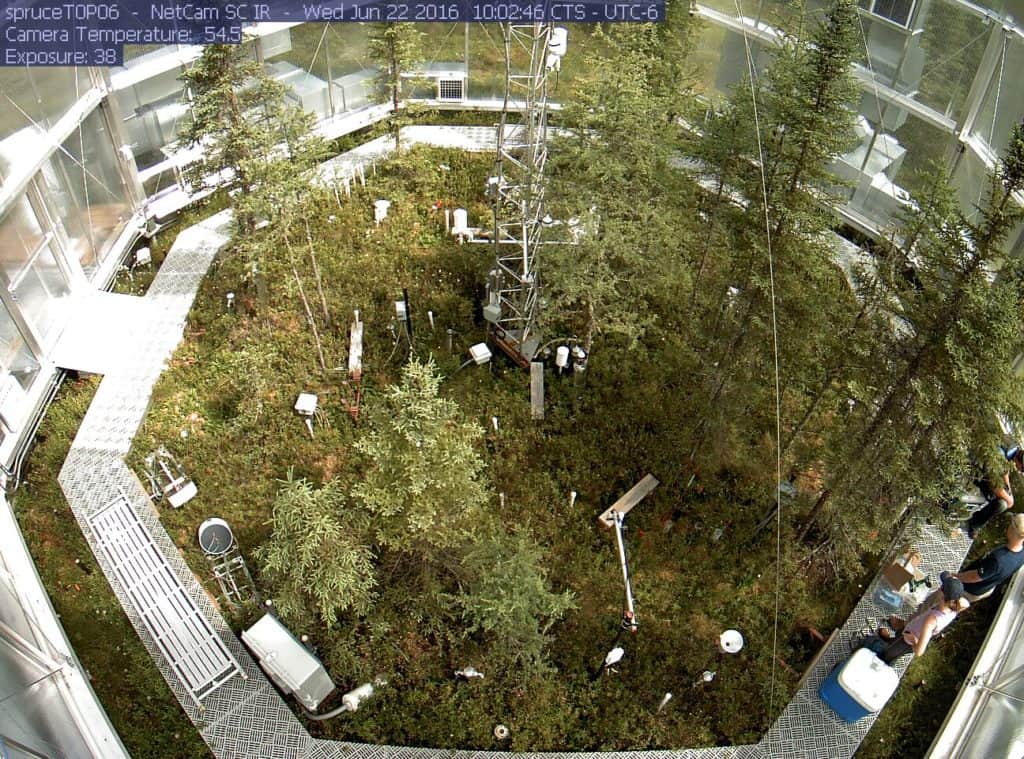
A ten-year research project north of Grand Rapids, Minnesota could reveal the ecological effects of climate change that is expected to occur over the next few decades. The project is seeing how global warming can affect trees, shrubs, and moss native to peat bogs, and how the bogs themselves could cause increased warming.
Located in the Marcell Experimental Forest and funded by the U.S. Department of Energy, the Spruce and Peatland Responses Under Changing Environments (SPRUCE) study has built 10 enclosures to simulate a warmer climate, and to measure how the bog responds.
“We think this gives us a good glimpse as to what future climates might look like,” says Paul Hanson, an ecologist at Oak Ridge National Laboratory in Tennessee and the experiment’s project coordinator. “It allows us to cheat today’s conditions and take on the whole ecosystem, from the top of the trees to the deep peat.”
Studying northern Minnesota’s peat bogs for global insight
Peatlands cover much of northern Minnesota, though only representing about three percent of Earth’s total land cover. Despite their relative rarity, they also contain 20 percent of all the carbon stored in the planet’s soils. Minnesota’s average temperature has risen 2.5 to 3 degrees since 1970, with the sharpest increase during winter. Climate scientists expect that trend to continue. As the climate changes, peatlands could start to release that carbon, accelerating the problem. This complex and critical relationship between climate and the landscape led to SPRUCE.
Eight of the 10 enclosures at the Marcell Experimental Forest simulate different levels of warming that are possible before the end of the century, from relatively minor to massive. Two other enclosures are not manipulated, and serve as a valuable control.
“It’s the only place on the planet that’s simulating climate change to the degree that we think it’s [actually] going to happen,” Randy Kolka, a research scientist with the USDA Forest Service, told KARE 11. “And it’s right here in northern Minnesota.”
Already seeing results
Four years in, the scientists are already seeing significant results. Enclosures with four degrees Fahrenheit of warming, which is a “middle-of-the-road” scenario likely to be met by the year 2100, have seen longer growing seasons that are affecting tamaracks and other common trees.
In the chamber with the most significant warming, heated up by 14 degrees, most of the trees are dead. Shrubs have exploded, killing the moss underneath, and causing the sort of carbon release that scientists fear. Already, the peat is about two inches lower than at the beginning, as it breaks down and release carbon dioxide and methane into the atmosphere.
“As climates warm, more and more carbon is going to be coming out of these ecosystems, and as more carbon comes out of these ecosystems, it’s going to acerbate climate change, because the greenhouse gases will increase the amount of warming,” Kolka said.
Instead of storing carbon and keeping it out of the atmosphere, this peatland has begun contributing to the excess amounts already in the atmosphere.
It is hoped that improved understanding of how peatlands store and release carbon, and how climate change affects their ability to do so, will help the public and policy-makers make better decisions about mitigating climate change.
Watch the video:
More information:
- Spruce and Peatland Responses Under Changing Environments – Oak Ridge National Laboratory
- Tucked away in a northern Minnesota forest, researchers work on first-of-its-kind climate change experiment – KARE 11
- Spruce and Peatland Responses Under Changing Environments – U.S. Forest Service
- Seeing the Future – Researchers experiment with climate change in a northern peatland – Minnesota Conservation Volunteer

